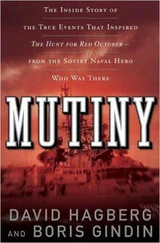.. Now they had a different mission, a new development in the Atlantic submarine game. For three weeks, the Dallas was to report on traffic in and out of Red Route One. Over the past fourteen months, newer Soviet submarines had been using a strange, effective tactic for shedding their American and British shadowers. Southwest of Iceland the Russian boats would race down the Reykjanes Ridge, a finger of underwater highlands pointing to the deep Atlantic basin. Spaced at intervals from five miles to half a mile, these mountains with their knife-edged ridges of brittle igneous rock rivaled the Alps in size. Their peaks were about a thousand feet beneath the stormy surface of the North Atlantic. Before the late sixties submarines could barely approach the peaks, much less probe their myriad valleys. Throughout the seventies Soviet naval survey vessels had been seen patrolling the ridge - in all seasons, in all weather, quartering and requartering the area in thousands of cruises. Then, fourteen months before the Dallas' present patrol, the USS Los Angeles had been tracking a Soviet VictorII-class attack submarine. The Victor had skirted the Icelandic coast and gone deep as she approached the ridge. The Los Angeles had followed. The Victor proceeded at eight knots until she passed between the first pair of seamounts, informally known as Thor's Twins. All at once she went to full speed and moved southwest. The skipper of the Los Angeles made a determined effort to track the Victor and came away from it badly shaken. Although the 688-class submarines were faster than the older Victors, the Russian submarine had simply not slowed down - for fifteen hours, it was later determined. At first it had not been all that dangerous. Submarines had highly accurate inertial navigation systems able to fix their positions to within a few hundred yards from one second to another. But the Victor was skirting cliffs as though her skipper could see them, like a fighter dodging down a canyon to avoid surface-to-air missile fire. The Los Angeles could not keep track of the cliffs. At any speed over twenty knots both her passive and active sonar, including the echo fathometer, became almost useless. The Los Angeles thus found herself navigating completely blind. It was, the skipper later reported, like driving a car with the windows painted over, steering with a map and a stopwatch. This was theoretically possible, but the captain quickly realized that the inertial navigation system had a built-in error factor of several hundred yards; this was aggravated by gravitational disturbances, which affected the "local vertical," which in turn affected the inertial fix. Worst of all, his charts were made for surface ships. Objects below a few hundred feet had been known to be misplaced by miles - something that mattered to no one until recently. The interval between mountains had quickly become less than his cumulative navigational error - sooner or later his submarine would drive into a mountainside at over thirty knots. The captain backed off. The Victor got away. Initially it was theorized that the Soviets had somehow staked out one particular route, that their submarines were able to follow it at high speed. Russian skippers were known to pull some crazy stunts, and perhaps they were trusting to a combination of inertial systems, magnetic and gyro compasses attuned to a specific track. This theory had never developed much of a following, and in a few weeks it was known for certain that the Soviet submarines speeding through the ridge were following a multiplicity of tracks. The only thing American and British subs could do was stop periodically to get a sonar fix of their positions, then race to catch up. But the Soviet subs never slowed, and the 688s and Trafalgar^ kept falling behind. The Dallas was on Toll Booth station to monitor passing Russian subs, to watch the entrance to the passage the U.S. Navy was now calling Red Route One, and to listen for any external evidence of a new gadget that might enable the Soviets to run the ridge so boldly. Until the Americans could copy it, there were three unsavory alternatives: they could continue losing contact with the Russians; they could station valuable attack subs at the known exits from the route; or they could set up a whole new SOSUS line. Jones' trance lasted ten minutes - longer than usual. He ordinarily had a contact figured out in far less time. The sailor leaned back and lit a cigarette. "Got something, Mr. Thompson." "What is it?" Thompson leaned against the bulkhead. "I don't know." Jones picked up a spare set of phones and handed them to his officer. "Listen up, sir." Thompson himself was a masters candidate in electrical engineering, an expert in sonar system design. His eyes screwed shut as he concentrated on the sound. It was a very faint low-frequency rumble - or swish. He couldn't decide. He listened for several minutes before setting the headphones down, then shook his head. "I got it a half hour ago on the lateral array," Jones said. He referred to a subsystem of the BQQ-5 multifunction submarine sonar. Its main component was an eighteen-foot-diameter dome located in the bow. The dome was used for both active and passive operations. A new part of the system was a gang of passive sensors which extended two hundred feet down both sides of the hull. This was a mechanical analog to the sensory organs on the body of a shark. "Lost it, got it back, lost it, got it back," Jones went on. "It's not screw sounds, not whales or fish. More like water going through a pipe, except for that funny rumble that comes and goes. Anyway, the bearing is about two-five-zero. That puts it between us and Iceland, so it can't be too far away." "Let's see what it looks like. Maybe that'll tell us something." Jones took a double-plugged wire from a hook. One plug went into a socket on his sonar panel, the other into the jack on a nearby oscilloscope. The two men spent several minutes working with the sonar controls to isolate the signal. They ended up with an irregular sine wave which they were only able to hold a few seconds at a time. "Irregular," Thompson said. "Yeah, it's funny. It sounds regular, but it doesn't look regular. Know what I mean, Mr. Thompson?" "No, you've got better ears." "That's cause I listen to better music, sir. That rock stuff'll kill your ears." Thompson knew he was right, but an Annapolis graduate doesn't need to hear that from an enlisted man. His vintage Janis Joplin tapes were his own business. "Next step." "Yessir." Jones took the plug from the oscilloscope and moved it into a panel to the left of the sonar board, next to a computer terminal. During her last overhaul, the Dallas had received a very special toy to go along with her BQQ-5 sonar system. Called the BC-10, it was the most powerful computer yet installed aboard a submarine. Though only about the size of a business desk, it cost over five million dollars and ran at eighty million operations per second. It used newly developed sixty-four-bit chips and made use of the latest processing architecture. Its bubble memory could easily accommodate the computing needs of a whole squadron of submarines. In five years every attack sub in the fleet would have one. Its purpose, much like that of the far larger SOSUS system, was to process and analyze sonar signals; the BC-10 stripped away ambient noise and other naturally produced sea sounds to classify and identify man-made noise. It could identify ships by name from their individual acoustical signatures, much as one could identify the finger or voice prints of a human. As important as the computer was its programming software. Four years before, a PhD candidate in geophysics who was working at Cal Tech's geophysical laboratory had completed a program of six hundred thousand steps designed to predict earthquakes. The problem the program addressed was one of signal versus noise. It overcame the difficulty seismologists had discriminating between random noise that is constantly monitored on seismographs and genuinely unusual signals that foretell a seismic event.
Читать дальше











